It's An RGB Disco: The GIGABYTE X299 Gaming 7 Pro Motherboard, Reviewed
by Joe Shields on January 26, 2018 8:00 AM EST- Posted in
- Motherboards
- Gaming
- Intel
- Gigabyte
- AORUS
- RGB
- X299
- Basin Falls
- Skylake-X
- Gaming 7 Pro
CPU Performance, Short Form
For our motherboard reviews, we use our short form testing method. These tests usually focus on if a motherboard is using MultiCore Turbo (the feature used to have maximum turbo on at all times, giving a frequency advantage), or if there are slight gains to be had from tweaking the firmware. We leave the BIOS settings at default and memory at JEDEC for the supported frequency of the processor for these tests, making it very easy to see which motherboards have MCT enabled by default.
Rendering - Blender 2.78: link
For a render that has been around for what seems like ages, Blender is still a highly popular tool. We managed to wrap up a standard workload into the February 5 nightly build of Blender and measure the time it takes to render the first frame of the scene. Being one of the bigger open source tools out there, it means both AMD and Intel work actively to help improve the codebase, for better or for worse on their own/each other's microarchitecture.
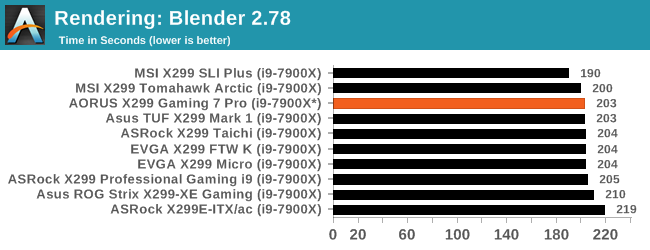
In our Blender results, the Gaming 7 Pro sits on the upper-middle side of the results completing the benchmark in 203 seconds. This data point again shows the CPU able to clock up to the 3.6 GHz value we see most boards tackle this testing at.
Rendering – POV-Ray 3.7: link
The Persistence of Vision Ray Tracer, or POV-Ray, is a freeware package for as the name suggests, ray tracing. It is a pure renderer, rather than modeling software, but the latest beta version contains a handy benchmark for stressing all processing threads on a platform. We have been using this test in motherboard reviews to test memory stability at various CPU speeds to good effect – if it passes the test, the IMC in the CPU is stable for a given CPU speed. As a CPU test, it runs for approximately 2-3 minutes on high-end platforms.
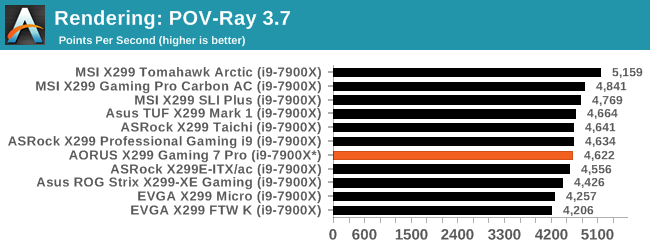
POV-Ray often becomes sensitive to immediate frequency, with the MCE boards taking the lead. The Gaming 7 Pro scores right in the middle of the pack at 4,622. The CPU boosted to 3.6 GHz like many others do in this testing outside of the EVGA boards who revert back to base clock for whatever reason.
Compression – WinRAR 5.4: link
Our WinRAR test from 2013 is updated to the latest version of WinRAR at the start of 2014. We compress a set of 2867 files across 320 folders totaling 1.52 GB in size – 95% of these files are small typical website files, and the rest (90% of the size) are small 30-second 720p videos.
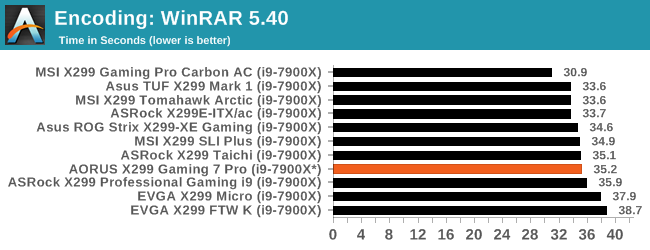
WinRAR results put the AORUS X299 Gaming 7 Pro in the lower-middle part of the pack here at 35.2 seconds.
Synthetic – 7-Zip 9.2: link
As an open source compression tool, 7-Zip is a popular tool for making sets of files easier to handle and transfer. The software offers up its own benchmark, to which we report the result.

The 7-Zip results land the AORUS offering in the middle of the very tightly packed datasets. In this test, the CPU boosted to 4GHz as did the majority in this group. The outlier was by our MSI top result, but was repeatable.
Point Calculations – 3D Movement Algorithm Test: link
3DPM is a self-penned benchmark, taking basic 3D movement algorithms used in Brownian Motion simulations and testing them for speed. High floating point performance, MHz, and IPC win in the single thread version, whereas the multithread version has to handle the threads and loves more cores. For a brief explanation of the platform agnostic coding behind this benchmark, see my forum post here.
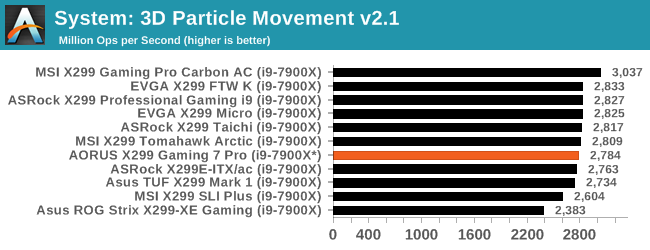
Similarly, the 3DPM result puts the AORUS board in the middle of the pack. During this test it performs six mini tests with a 10-second gap between them: our result were from a 3.6 GHz CPU clockspeed during the test.
Neuron Simulation - DigiCortex v1.20: link
The newest benchmark in our suite is DigiCortex, a simulation of biologically plausible neural network circuits, and simulates activity of neurons and synapses. DigiCortex relies heavily on a mix of DRAM speed and computational throughput, indicating that systems which apply memory profiles properly should benefit and those that play fast and loose with overclocking settings might get some extra speed up. Results are taken during the steady state period in a 32k neuron simulation and represented as a function of the ability to simulate in real time (1.000x equals real-time).
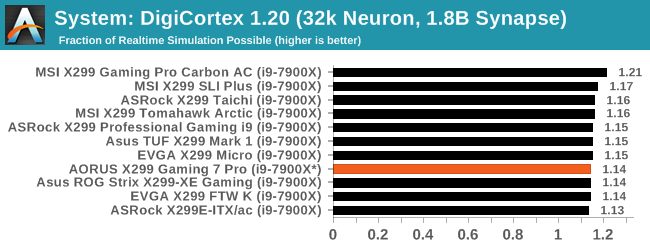
In the DigiCortex testing, the AORUS is wedged in with the other results with a 1.14 result and is part of a tightly packed set of data. The only outlier here is again the MSI Gaming Pro Carbon AC which seems to throw little caution to the wind for performance sake.










29 Comments
View All Comments
tech6 - Friday, January 26, 2018 - link
Welcome to another episode of Pimp my Mobo.I'm sure its a great board but that LED craze cannot end soon enough.
Manch - Friday, January 26, 2018 - link
Yeah, don't care for the RGB crap. I have an corsair keyboard that lights up red for when its dark. That's it.The board feature list is nice but id like to see a compare to the rest of the line up and its competitors.
Can yall add that Joe?
Joe Shields - Friday, January 26, 2018 - link
That is an incredible amount of data entry considering the sheer number of boards on the platform (over 50 IIRC). Between Newegg and the board partner's websites, who both offer 'compare' functionality, should show at least some of what you are looking for.Ian Cutress - Friday, January 26, 2018 - link
It gives me an idea for a project.WithoutWeakness - Tuesday, January 30, 2018 - link
I use the Bench all the time to compare GPUs, especially to get an idea of how high end cards from 3-4 generations ago stack up against newer mid-range cards. If you guys can build a comprehensive tool to narrow down motherboards based on features it would be great. Currently my go-to sites are Newegg and PCPartPicker but having another tool to compliment those would be awesome.Manch - Monday, January 29, 2018 - link
Fair enough. What about a cut down version of just its main competitors? Would that be a small enough list, or is the price point that crowded? You spend a good bit talking about picking a board based on features without making a recommendation so I think a comparo table would be helpful.justaviking - Friday, January 26, 2018 - link
Soon we will need a second power supply in our systems... one we can dedicate to all the LEDs that dazzle us.Beaver M. - Sunday, January 28, 2018 - link
Not to mention extra cooling, because that many LEDs also produce quite some heat.milkod2001 - Friday, January 26, 2018 - link
Yeah it is stupid indeed, you pay extra for something you never asked for. Fortunately you should be able to completely switch all LEDs off if desired.Cygni - Friday, January 26, 2018 - link
I, too, get mad about things that add next to no price to motherboards that I can just turn off and ignore.